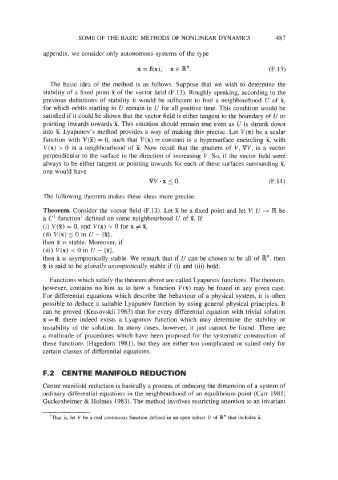Page 517 - Fluid-Structure Interactions Slender Structure and Axial Flow (Volume 1)
P. 517
SOME OF THE BASIC METHODS OF NONLINEAR DYNAMICS 487
appendix, we consider only autonomous systems of the type
x = f(x), x E R". (F. 13)
The basic idea of the method is as follows. Suppose that we wish to determine the
stability of a fixed point X of the vector field (F.13). Roughly speaking, according to the
previous definitions of stability it would be sufficient to find a neighbourhood U of X,
for which orbits starting in U remain in U for all positive time. This condition would be
satisfied if it could be shown that the vector field is either tangent to the boundary of U or
pointing inwards towards X. This situation should remain true even as U is shrunk down
into JE. Lyapunov's method provides a way of making this precise. Let V(x) be a scalar
function with V(X) = 0, such that V(x) = constant is a hypersurface encircling X, with
V(x) > 0 in a neighbourhood of X. Now recall that the gradient of V, VV, is a vector
perpendicular to the surface in the direction of increasing V. So, if the vector field were
always to be either tangent or pointing inwards for each of these surfaces surrounding X,
one would have
vv.x 5 0. (F. 14)
The following theorem makes these ideas more precise.
Theorem. Consider the vector field (F.13). Let X be a fixed point and let I/: U -+ R be
a C' function' defined on some neighbourhood U of X. If
(i) V(X) = 0, and V(x) > 0 for x # X,
(ii) V(x) 5 o in u - {XI,
then X is stable. Moreover, if
(iii) V(x) < 0 in u - (531,
then X is asymptotically stable. We remark that if U can be chosen to be all of R", then
X is said to be globally asymptotically stable if (i) and (iii) hold.
Functions which satisfy the theorem above are called Lyapunov functions. The theorem,
however, contains no hint as to how a function V(x) may be found in any given case.
For differential equations which describe the behaviour of a physical system, it is often
possible to deduce a suitable Lyapunov function by using general physical principles. It
can be proved (Krasovskii 1963) that for every differential equation with trivial solution
x = 0, there indeed exists a Lyapunov function which may determine the stability or
instability of the solution. In many cases, however, it just cannot be found. There are
a multitude of procedures which have been proposed for the systematic construction of
these functions (Hagedorn 1981), but they are either too complicated or suited only for
certain classes of differential equations.
F.2 CENTRE MANIFOLD REDUCTION
Centre manifold reduction is basically a process of reducing the dimension of a system of
ordinary differential equations in the neighbourhood of an equilibrium point (Can 198 1 ;
Guckenheimer & Holmes 1983). The method involves restricting attention to an invariant
+That is, let V be a real continuous function defined in an open subset II of R" that includes E.

